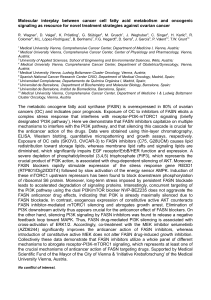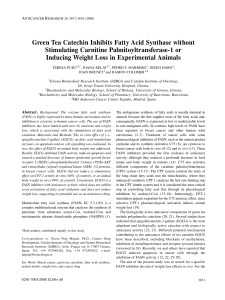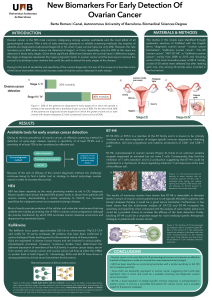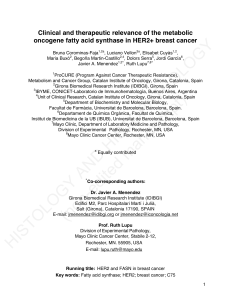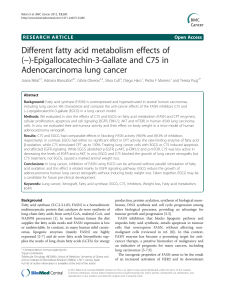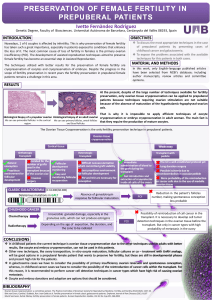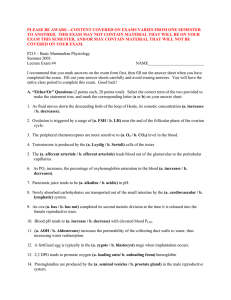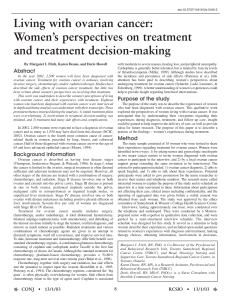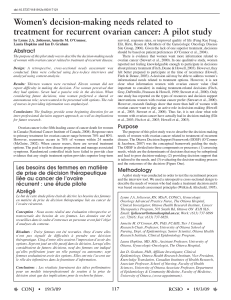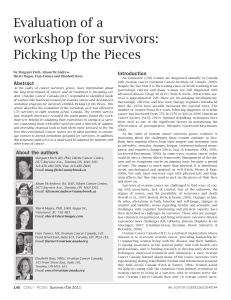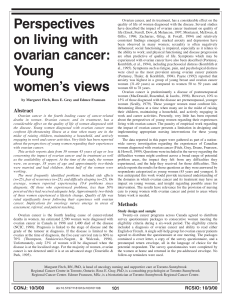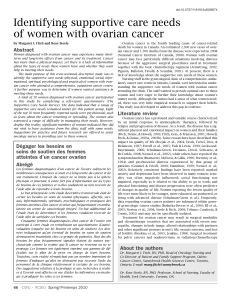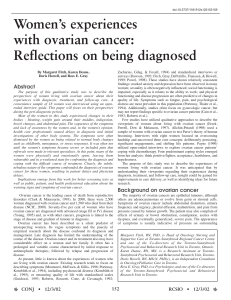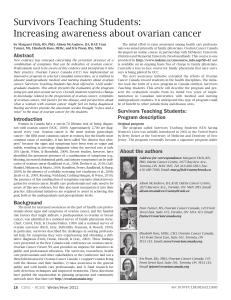645394.pdf
publicité
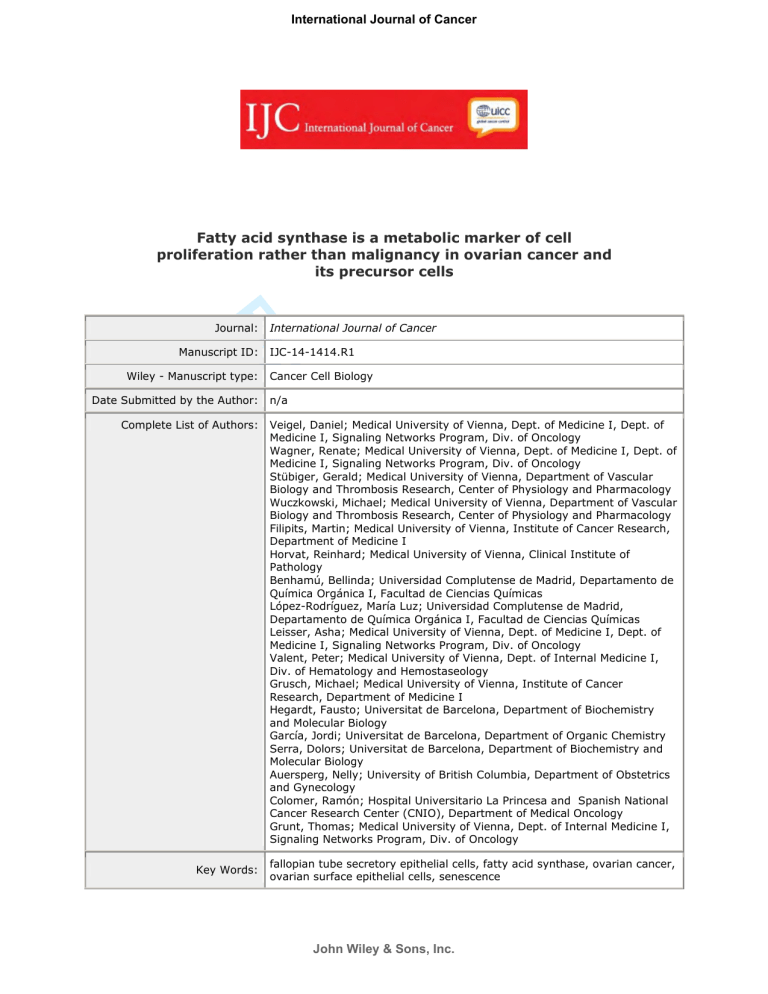
International Journal of Cancer Fatty acid synthase is a metabolic marker of cell proliferation rather than malignancy in ovarian cancer and its precursor cells r Fo Journal: Manuscript ID: Wiley - Manuscript type: Date Submitted by the Author: IJC-14-1414.R1 Cancer Cell Biology n/a Pe Complete List of Authors: International Journal of Cancer er Veigel, Daniel; Medical University of Vienna, Dept. of Medicine I, Dept. of Medicine I, Signaling Networks Program, Div. of Oncology Wagner, Renate; Medical University of Vienna, Dept. of Medicine I, Dept. of Medicine I, Signaling Networks Program, Div. of Oncology Stübiger, Gerald; Medical University of Vienna, Department of Vascular Biology and Thrombosis Research, Center of Physiology and Pharmacology Wuczkowski, Michael; Medical University of Vienna, Department of Vascular Biology and Thrombosis Research, Center of Physiology and Pharmacology Filipits, Martin; Medical University of Vienna, Institute of Cancer Research, Department of Medicine I Horvat, Reinhard; Medical University of Vienna, Clinical Institute of Pathology Benhamú, Bellinda; Universidad Complutense de Madrid, Departamento de Química Orgánica I, Facultad de Ciencias Químicas López-Rodríguez, María Luz; Universidad Complutense de Madrid, Departamento de Química Orgánica I, Facultad de Ciencias Químicas Leisser, Asha; Medical University of Vienna, Dept. of Medicine I, Dept. of Medicine I, Signaling Networks Program, Div. of Oncology Valent, Peter; Medical University of Vienna, Dept. of Internal Medicine I, Div. of Hematology and Hemostaseology Grusch, Michael; Medical University of Vienna, Institute of Cancer Research, Department of Medicine I Hegardt, Fausto; Universitat de Barcelona, Department of Biochemistry and Molecular Biology García, Jordi; Universitat de Barcelona, Department of Organic Chemistry Serra, Dolors; Universitat de Barcelona, Department of Biochemistry and Molecular Biology Auersperg, Nelly; University of British Columbia, Department of Obstetrics and Gynecology Colomer, Ramón; Hospital Universitario La Princesa and Spanish National Cancer Research Center (CNIO), Department of Medical Oncology Grunt, Thomas; Medical University of Vienna, Dept. of Internal Medicine I, Signaling Networks Program, Div. of Oncology ew vi Re Key Words: fallopian tube secretory epithelial cells, fatty acid synthase, ovarian cancer, ovarian surface epithelial cells, senescence John Wiley & Sons, Inc. Page 1 of 34 r Fo er Pe ew vi Re 1 2 3 4 5 6 7 8 9 10 11 12 13 14 15 16 17 18 19 20 21 22 23 24 25 26 27 28 29 30 31 32 33 34 35 36 37 38 39 40 41 42 43 44 45 46 47 48 49 50 51 52 53 54 55 56 57 58 59 60 International Journal of Cancer John Wiley & Sons, Inc. International Journal of Cancer Fatty acid synthase is a metabolic marker of cell proliferation rather than malignancy in ovarian cancer and its precursor cells Daniel Veigel1,2*, Renate Wagner1,2*, Gerald Stübiger2,3, Michael Wuczkowski3, Martin Filipits2,4, Reinhard Horvat5, Bellinda Benhamú6, María Luz López-Rodríguez6, Asha Leisser1,13, Peter Valent2,7,13, Michael Grusch2,4, Fausto G. Hegardt8,9, Jordi García9,10, Dolors Serra8,9, Nelly Auersperg11, Ramón Colomer12, Thomas W. Grunt1,2,13 1 Signaling Networks Program, Division of Oncology, Department of Medicine I, Medical University r Fo Vienna, Vienna, Austria 2 Comprehensive Cancer Center, Medical University Vienna, Vienna, Austria 3 Department of Vascular Biology and Thrombosis Research, Center of Physiology and Pharmacology, Pe Medical University Vienna, Vienna, Austria 4 er Institute of Cancer Research, Department of Medicine I, Medical University of Vienna, Vienna, Austria Re 5 Clinical Institute of Pathology, Medical University of Vienna, Vienna, Austria 6 Departamento de Química Orgánica I, Facultad de Ciencias Químicas, Universidad Complutense de Madrid, Madrid, Spain Division of Hematology and Hemostaseology, Department of Medicine I, Medical University Vienna, Vienna, Austria 8 ew 7 vi 1 2 3 4 5 6 7 8 9 10 11 12 13 14 15 16 17 18 19 20 21 22 23 24 25 26 27 28 29 30 31 32 33 34 35 36 37 38 39 40 41 42 43 44 45 46 47 48 49 50 51 52 53 54 55 56 57 58 59 60 Page 2 of 34 Department of Biochemistry and Molecular Biology, Facultat de Farmàcia, Universitat de Barcelona, Barcelona, Spain 9 Institut de Biomedicina de la Universitat de Barcelona (IBUB), Barcelona and CIBERobn Fisiopatología de la Obesidad y la Nutrición, Instituto de Salud Carlos III, Madrid, Spain 10 Department of Organic Chemistry, Facultat de Química, Universitat de Barcelona, Barcelona, Spain 11 Department of Obstetrics and Gynecology, University of British Columbia, Vancouver, BC, Canada 1 John Wiley & Sons, Inc. Page 3 of 34 12 Department of Medical Oncology, Hospital Universitario La Princesa and Spanish National Cancer Research Center (CNIO), Clinical Research Program, Madrid, Spain 13 Ludwig Boltzmann Cluster Oncology, Vienna, Austria * D.V. and R.W. contributed equally to this work. Correspondence to: Thomas W. Grunt, Division of Oncology, Department of Medicine I, Comprehensive Cancer Center, Medical University of Vienna, Waehringer Guertel 18 – 20, A-1090 Vienna, Austria, Tel.: +43-1-40400-54570, -44300, Fax: +43-1-40400-54650, E-mail: r Fo [email protected] Short title: FASN – a growth marker independent of cancer Key words: Fallopian tube secretory epithelial cells, fatty acid synthase, ovarian cancer, ovarian Pe surface epithelial cells, senescence er Abbreviations: CE: cholesterol ester; DAG: diacylglycerol; FASN: fatty acid synthase; FCS: fetal calf serum; OC: ovarian cancer; OSE: ovarian surface epithelial cells; PARP: poly (ADP-ribose) polymerase; Re PE: phosphatidylethanolamine; PC: phosphatidylcholine; PI: phosphatidylinositol; PL: phospholipid; PS: phosphatidylserine; SM: sphingomyelin; TAG: triacylglycerol; TLC thin-layer chromatography vi Manuscript Category: Research Article – Cancer Cell Biology ew 1 2 3 4 5 6 7 8 9 10 11 12 13 14 15 16 17 18 19 20 21 22 23 24 25 26 27 28 29 30 31 32 33 34 35 36 37 38 39 40 41 42 43 44 45 46 47 48 49 50 51 52 53 54 55 56 57 58 59 60 International Journal of Cancer Word count Abstract: 240 Word count Main Text: 4510 Supplementary information accompanies the paper. What’s new? Fatty acid synthase (FASN) has been regarded as marker of malignancy and as cancer drug target. Being overexpressed in cancer it regulates oncogenic de-novo-lipogenesis. There is general agreement that normal cells are FASN-negative. We now demonstrate that FASN is overexpressed in 2 John Wiley & Sons, Inc. International Journal of Cancer the ovarian system when cells reveal high growth rates, which correlates with distinctive lipid profiles, irrespective of their state of malignancy/differentiation/senescence. Thus, FASN represents a metabolic marker of ovarian cell proliferation rather than of cancer. r Fo er Pe ew vi Re 1 2 3 4 5 6 7 8 9 10 11 12 13 14 15 16 17 18 19 20 21 22 23 24 25 26 27 28 29 30 31 32 33 34 35 36 37 38 39 40 41 42 43 44 45 46 47 48 49 50 51 52 53 54 55 56 57 58 59 60 Page 4 of 34 3 John Wiley & Sons, Inc. Page 5 of 34 Abstract Ovarian cancer (OC) is caused by genetic aberrations in networks that control growth and survival. Importantly, aberrant cancer metabolism interacts with oncogenic signaling providing additional drug targets. Tumors overexpress the lipogenic enzyme fatty acid synthase (FASN) and are inhibited by FASN-blockers, whereas normal cells are FASN-negative and FASN-inhibitor-resistant. Here we demonstrate that this holds true when ovarian/oviductal cells reside in their autochthonous tissues, r Fo whereas in culture they express FASN and are FASN-inhibitor-sensitive. Upon subculture, nonmalignant cells cease growth, express senescence-associated-β-galactosidase, lose FASN and become FASN-inhibitor-resistant. Immortalized ovarian/oviductal epithelial cell lines – although resisting Pe senescence – reveal distinct growth activities, which correlate with FASN-levels and FASN-drugsensitivities. Accordingly, ectopic FASN stimulates growth in these cells. Moreover, FASN-levels and er lipogenic activities affect cellular lipid composition as demonstrated by thin-layer chromatography. Correlation between proliferation and FASN-levels was finally evaluated in cancer cells such as HOC- Re 7, which contain subclones with variable differentiation/senescence and corresponding FASN- vi expression/FASN-drug-sensitivity. Interestingly, senescent phenotypes can be induced in parental HOC-7 by differentiating agents. In OC cells, FASN-drugs induce cell cycle-blockade in S and/or G2/M ew 1 2 3 4 5 6 7 8 9 10 11 12 13 14 15 16 17 18 19 20 21 22 23 24 25 26 27 28 29 30 31 32 33 34 35 36 37 38 39 40 41 42 43 44 45 46 47 48 49 50 51 52 53 54 55 56 57 58 59 60 International Journal of Cancer and stimulate apoptosis, whereas in normal cells they only cause cell cycle-deceleration without apoptosis. Thus normal cells, although growth-inhibited, may survive and recover from FASNblockade, whereas malignant cells get extinguished. FASN-expression and FASN-drug-sensitivity are directly linked to cell growth and correlate with transformation/differentiation/senescence only indirectly. FASN is therefore a metabolic marker of cell proliferation rather than a marker of malignancy and is a useful target for future drug development. 4 John Wiley & Sons, Inc. International Journal of Cancer Introduction For the last thirty years cancer researchers paid most attention to the discovery of genetic alterations in oncogenic and tumor suppressor genes, which function as regulators of growth, migration and apoptosis.1 This led to the identification of cancer drug targets and corresponding therapeutics, which are added to the armamentarium in the fight against cancer. In the case of ovarian cancer (OC), however, this approach has yielded only limited benefits.2 Thus, especially for advanced OC, novel approaches are urgently needed. Notably, it has been known for decades that cancer cells r Fo reveal alterations in their metabolism such as aerobic glycolysis, acidosis, glutamine consumption and hypoxia.3,4 Recently, it has been recognized that metabolic pathways closely interact with Pe oncogenic networks and that altered oncogenes and tumor suppressor genes directly affect cancer cell metabolism.5 For instance, the proto-oncogene c-Myc crosstalks with hypoxia-inducible factors er enabling continued proliferation despite tissue hypoxia6 and spurs aerobic glycolysis and acidosis.7 Cancer cells not only have high demands for bioenergy for cell division provided by catabolic Re pathways, they also depend on supply with biomolecules for building new cell material. Both requirements are met by glycolytic breakdown of carbohydrates, which not only provide moderate vi levels of ATP, but also deliver components for biosynthesis of macromolecules.8 In addition, cancer ew 1 2 3 4 5 6 7 8 9 10 11 12 13 14 15 16 17 18 19 20 21 22 23 24 25 26 27 28 29 30 31 32 33 34 35 36 37 38 39 40 41 42 43 44 45 46 47 48 49 50 51 52 53 54 55 56 57 58 59 60 Page 6 of 34 cells have been found to reveal hyperactivation of de novo (phospho)lipid synthesis, which is required for production of biomembranes.9 Thus, fatty acid synthase (FASN), the key enzyme for production of palmitic acid, which is the precursor of all lipids,10 is overexpressed in cancer cells, confers chemoresistance and correlates with tumor progression.11-13 In contrast, most normal cells (except hepatocytes, adipocytes) are essentially negative for FASN.9 Interestingly, data from metabolic radiolabeling indicate that senescent cells, unlike proliferating cells, reveal reduced de novo synthesis of phospholipids (PLs), but elevated levels of cholesterol and of unsaturated fatty acids14 suggesting changes of lipid metabolism. Notably, high levels of EGFR-, HER2- or AKToncoprotein correlate with FASN overexpression/phosphorylation corroborating the link between 5 John Wiley & Sons, Inc. Page 7 of 34 oncogene pathways and metabolic systems.15-17 Most importantly, blunting FASN-action arrests growth and induces death in cancer cells prompting the development of FASN-inhibitory compounds for cancer treatment.18 Thus, FASN represents a cancer biomarker and a promising target. It is therefore tempting to speculate that FASN-targeting will represent a novel anti-metabolic approach to be added to the armamentarium against OC. In contrast to the widely accepted concept that normal cells are negative for FASN and insensitive against FASN-blockers, we report here that normal non-malignant human ovarian surface epithelial r Fo cells and oviduct secretory epithelial cells, from which high-grade serous OCs arise, do produce high amounts of FASN and depend on it for growth in culture. However, during ageing in culture, they downregulate FASN and lose responsiveness to FASN-inhibitors. Correspondingly, in the body, Pe healthy epithelia from the ovarian surface and from the fimbriae of the oviduct were quiescent and FASN-negative, whereas cancer tissues expressed FASN according to their growth activity. Using er FASN-targeting drugs we demonstrate that FASN-inhibition impairs cancer cells causing cell cycle block and apoptosis in vitro, whereas in healthy proliferating cells they only reduce cell cycle Re progression. Moreover, characteristic differences in the lipid profiles of non-malignant young and senescent cells and after FASN-inhibition in young cells were observed. In summary, our data vi demonstrate that FASN is associated with cell proliferation rather than with malignancy and that ew 1 2 3 4 5 6 7 8 9 10 11 12 13 14 15 16 17 18 19 20 21 22 23 24 25 26 27 28 29 30 31 32 33 34 35 36 37 38 39 40 41 42 43 44 45 46 47 48 49 50 51 52 53 54 55 56 57 58 59 60 International Journal of Cancer FASN is a useful cancer target since quiescent normal cells usually lack it and the few dividing normal cells, being positive for it, are not eliminated by the FASN-drugs. Materials and Methods Cell Culture and Drugs OC cell lines A2774, A2780, A2780-ADR (M.Krainer, Medical University Vienna, Austria), HEY, HOC-7 (R.N.Buick, University of Toronto, Canada), HOC-7 monoclonal derivatives N1-N3, D1-D3,19 TR170 (B.T.Hill, Imperial Cancer Research Fund, London, UK), OVCAR-3, PA-1, SKOV3 (ATCC, Manassas, VA) were maintained in alpha-MEM, RPMI1640 or DMEM, respectively, and were subcultured for ≤20 6 John Wiley & Sons, Inc. International Journal of Cancer passages. Immortalized human fallopian tube secretory epithelial cells engineered to overexpress hTERT together with either SV40T/t (FT33-TAg) or p53 shRNA plus mutant CDK4 (FT237-shp) (R.Drapkin, Dana-Farber Cancer Institute, Boston, MA)20 were cultivated in DMEM/Ham’sF12(1:2). Non-malignant human ovarian surface epithelial cells IOSE-80, IOSE-364, IOSE-386 (N.Auersperg, Canadian Ovarian Tissue Bank, British Columbia Cancer Research Centre, Canada) revealing extended but finite life span due to exogenous expression of SV40T/t21 were grown in Medium199/MCDB105(1:2). Primary human ovarian surface epithelial cells (OSE; Innoprot, Derio, Spain) were cultivated in OSE-medium containing 1%OSE-supplement and 100IU(µg)/ml penicillin- r Fo streptomycin (Innoprot). For adherence of OSE, surfaces were pre-coated with 2µg poly-L-lysine/cm2 according to manufacturer’s protocols. Normal human foreskin fibroblasts (CRL-2522, ATCC) were cultured in alpha-MEM. Media, except OSE-medium, were supplemented with 5 or 10% fetal calf Pe serum (FCS), 100IU(µg)/ml penicillin-streptomycin and 2mM glutamine (Gibco, Karlsruhe, Germany). er Cells were maintained at 37°C, 5%CO2 and 95%humidity and were tested for absence of viral/bacterial/fungal/mycoplasmal infection (Venor GeM, Minerva Biolabs, Berlin, Germany). The Re species origins were proven by species-PCR, and cell line identities were examined by fluorescent nonaplex-PCR of short tandem repeat markers (DSMZ, Braunschweig, Germany). FASN-inhibitors C75 vi (racemic mixture of (-)- and (+)-enantiomers, Sigma, St. Louis, MO), (-)-C75, (+)-C75 (F.G.Hegardt, ew 1 2 3 4 5 6 7 8 9 10 11 12 13 14 15 16 17 18 19 20 21 22 23 24 25 26 27 28 29 30 31 32 33 34 35 36 37 38 39 40 41 42 43 44 45 46 47 48 49 50 51 52 53 54 55 56 57 58 59 60 Page 8 of 34 D.Serra, Barcelona, Spain)22 and G28UCM (R.Colomer, M.L.López Rodríguez, Madrid, Spain)23,24 were dissolved in DMSO and diluted 1:500 or 1:1,000 in media before use. Cells were usually treated with racemic C75 except one experiment, in which racemic C75 was compared with the enantiomers. DNA Constructs and Transfections Full-length wild-type human FASN cDNA (NM004104) cloned into pcDNA3 was provided by J.-T.Zhang (Indiana University School of Medicine, Indianapolis, IN).25 For transfection, 8x105 senescent (passage24–26) IOSE-80 cells were plated in 35mm tissue culture dishes and further processed as described.26 Transiently transfected, polyclonal cell populations were subjected to BrdU-labeling or to Western blot-analysis (see below). For stable transgene expression, transfectants were exposed to 7 John Wiley & Sons, Inc. Page 9 of 34 300µg/mlG418 (Merck KGaA, Darmstadt, Germany) for ≥3 weeks. Cells were then trypsinized and counted under the microscope. Cell Proliferation Cells (250-4,500/well, 96-well plate) attached overnight before media containing 5%FCS or 1%OSEsupplement±drugs were added. Cell numbers were estimated using a formazan-dye-assay (Biomedica, Vienna, Austria). DNA Synthesis r Fo Incorporation of 5-bromo-2'-deoxyuridine (BrdU) into nascent DNA-strands was used for determination of DNA-synthesis using the Cell Proliferation ELISA, BrdU (colorimetric) from Roche Pe (Penzberg, Germany). IOSE-80, IOSE-364, IOSE-386 cells (1500/well) or FT33-TAg, FT237-shp (6000/well) were grown in 96-well plates in media containing 5 or 10%FCS for 48h followed by a 6h- er incubation in BrdU-labeling solution at 37°C, 5%CO2, 95%humidity. Subsequent immunodetection was performed according to manufacturer’s protocols. Western Blotting vi Re Cells plated in media containing 5%FCS or 1%OSE-supplement were treated with solvent ew 1 2 3 4 5 6 7 8 9 10 11 12 13 14 15 16 17 18 19 20 21 22 23 24 25 26 27 28 29 30 31 32 33 34 35 36 37 38 39 40 41 42 43 44 45 46 47 48 49 50 51 52 53 54 55 56 57 58 59 60 International Journal of Cancer (≤0.2%DMSO) in the absence/presence of C75 or G28UCM, or with DMSO alone at doses of 1.5% or 1.8%. At this high concentrations DMSO acts as differentiation-inducer.27,28 After cell lysis proteins were subjected to SDS–PAGE, blotted and immunostained as described29 using: anti-FASN (BD Biosciences, Franklin Lakes, NJ, 1:500), anti-β-gal (Santa Cruz Biotechnology, Santa Cruz, CA, 1:200), anti-PARP-1 (1:500), anti-α,β-tubulin (both from Cell Signaling Technology, Boston, MA, 1:1,000), and anti-actin (I-19, Santa Cruz Biotechnology, 1:1,000). Secondary antibodies were peroxidase-labelled donkey-anti-rabbit (Promega, Madison, WI), donkey-anti-goat or chicken anti-mouse IgG (both from Santa Cruz Biotechnology) at 1:15,000. Detection was by enhanced chemiluminescence. In-situ Staining for Senescence-Associated-β-Galactosidase (SA-β-gal) 8 John Wiley & Sons, Inc. International Journal of Cancer See ‘Supplementary Information’ Lipid Extraction Published protocols were used.30 Briefly, 105–106 suspended cells were washed 3x with PBS containing 0.5mM EDTA and 0.01% butylated hydroxytoluene (antioxidants), centrifuged (5000xg, 5min), resuspended in 100µl H2O before 1.6ml CHCl3:MeOH[70:30(v/v)] was added, sonicated for 1min and incubated on ice for 30min. Then, 0.4ml of 0.7M aqueous formic acid was added, vortexed and centrifuged (5000xg, 5min) to separate lower organic phase containing most neutral- and r Fo phospholipids from upper phase. Lipids from lower phase were vacuum dried, redissolved in 50µl CHCl3:MeOH (70:30) and stored at ≤-20°C. Thin-layer Chromatography Pe Plates (ALUGRAM Nano-SIL-G, Macherey-Nagel, Düren, Germany) were developed full-length er (10cm) with pure hexane, rotated by 90° and redeveloped full-length, then dried on a heating-plate (150°C, 20min) and 8-10µl of lipid extracts were applied. Plates were developed using methyl- Re acetate:1-propanol:CHCl3:methanol:0.25%KCl[25:25:25:10:9(v/v/v/v/v)]31 until 4.5cm from origin for separation of PLs, dried by hot air (1-2min) and developed again using hexane:diethyl ether:acetic vi acid[80:20:1.5(v/v/v)]32 until 9.5cm from origin for separation of neutrallipids. Plates were redried, ew 1 2 3 4 5 6 7 8 9 10 11 12 13 14 15 16 17 18 19 20 21 22 23 24 25 26 27 28 29 30 31 32 33 34 35 36 37 38 39 40 41 42 43 44 45 46 47 48 49 50 51 52 53 54 55 56 57 58 59 60 Page 10 of 34 sprayed with 0.05% primuline33, photographed under UV-light and evaluated using GelAnalyzer software (http://www.gelanalyzer.com/). Active Caspase 3 Assay Cells (6x105/flask) attached overnight in media containing 5%FCS or 1%OSE-supplement before 48hexposure to ≤0.2% DMSO without/with C75 or G28UCM, trypsinized and counted. 2x105 cells were fixed in 2%formaldehyde (15min, room temperature) followed by overnight permeabilization in pure methanol at -20°C and immunostaining with phycoerythrin-tagged anti-active caspase 3 (BD Pharmingen, San Diego, CA; 3% in 0.1%BSA-buffer) for 30min at room temperature. Data obtained in 9 John Wiley & Sons, Inc. Page 11 of 34 a BD FACScan were analyzed using ‘Flowing Software 2’ (P. Terho, Turku Centre for Biotechnology, Finland). Boundaries between regions H1(viable) and H2(apoptotic) were set at the right slope-base of the peak in the histograms of untreated cells labelled with isotype-control antibody and were applied to all samples. Cell Cycle Analysis Cells were treated and harvested as described for active caspase 3 assay. However, instead of formaldehyde-fixation, cells were incubated overnight at -20°C in 80%ethanol and then labelled for r Fo 20min at room temperature with propidium iodide (50µg/ml in buffer containing 0.1%TritonX-100, 0.1mMEDTA and 50µg/mlRNAseA). Stained samples were subjected to flow cytometry and analyzed using ModFit-software (Verity Software House, Topsham, ME). Vehicle-treated (≤0.2%DMSO) cells were used as control. Statistical Analysis er Pe Student’s t-test or one-way ANOVA followed by Scheffe or Holm-Sidak post-hoc tests. p-Values below 0.05 were statistically significant. ew vi Results Re 1 2 3 4 5 6 7 8 9 10 11 12 13 14 15 16 17 18 19 20 21 22 23 24 25 26 27 28 29 30 31 32 33 34 35 36 37 38 39 40 41 42 43 44 45 46 47 48 49 50 51 52 53 54 55 56 57 58 59 60 International Journal of Cancer Cultured non-malignant ovarian/oviductal cells express FASN and are growth-arrested by FASN inhibitors It has repeatedly been shown that non-malignant cells express either no FASN or only very low levels of FASN and consequently are not affected by FASN-blockers.9,18 However, such a difference in cancer versus normal cells has never been demonstrated for the ovarian cell system. Therefore, we compared the growth effects of C75 and G28UCM on malignant OC cell lines with those on nonmalignant OSE and fallopian tube secretory epithelial (FT) cells, the two cell types, which are being discussed to represent the cells of origin from which most OCs arise.20,34,35 The growth-inhibitory activity of C75 and G28UCM varied extensively within a panel of 9 OC cell lines with IC50-values 10 John Wiley & Sons, Inc. International Journal of Cancer ranging from 11-31µM and from 3-25µM, respectively (Figure 1a). The novel FASN-inhibitor G28UCM was generally more potent than C75 (p<0.01 for OVCAR-3 and HEY, p<0.001 for all others). Drugmediated growth-inhibition and cellular FASN-protein levels revealed a weak but significant inverse correlation in OC cells (r=-0.51, p<0.05) corroborating previous findings suggesting that FASN-drug sensitivity correlates with target expression.16,36,37 For comparison, non-malignant short-lived OSE without or with exogenous expression of SV40T/t-antigen – the latter yielding longer-lived cell lines IOSE-80, IOSE-364 and IOSE-386 – were exposed to FASN-drugs. Most surprisingly, we observed that these non-cancer ovarian cells were exquisitely sensitive to the inhibitors (IC50-values 3-13µM, which r Fo is discordant with results in other benign cell lines. Similar data were obtained in immortalized FT cells (IC50 3–27µM). Correspondingly, all these non-malignant cells contained large amounts of FASN as demonstrated by Western blotting (Figure 1b). In contrast, CRL-2522 normal fibroblasts were Pe rather resistant against C75 and G28UCM (IC50>48µM and >30µM, respectively) and were essentially er negative for FASN (Figures 1a,b). Generic C75 is a racemic mixture of (+)- and (-)-enantiomers. However, only the (-)-form interferes with FASN-activity.22 Consequently, (-)-C75 inhibits growth at Re least as efficiently as the mixture, whereas (+)-C75 lacks efficacy (Figure 1c). This data together with the inefficiency of racemic C75 and G28UCM on fibroblasts suggests that non-malignant vi ovarian/oviductal cells are not inhibited due to off-target drug effects. ew 1 2 3 4 5 6 7 8 9 10 11 12 13 14 15 16 17 18 19 20 21 22 23 24 25 26 27 28 29 30 31 32 33 34 35 36 37 38 39 40 41 42 43 44 45 46 47 48 49 50 51 52 53 54 55 56 57 58 59 60 Page 12 of 34 Inhibition of FASN in OC causes conversion of membrane-phospholipids (PLs) into storage-lipids Conceivably, inhibitors of FASN activity not only block cell growth, but also severely affect cell lipid composition. Here, we used SKOV3 (Figure 1d) and OVCAR-3 (Figure 1e) as representative examples of OC cells and performed thin-layer chromatography (TLC) separation of lipid extracts for examining the effects of C75 and G28UCM on the lipid pattern. Three major neutrallipid classes inluding cholesterol esters (CE), triacylglycerols (TAG), and diacylglycerols (DAG) as well as three PL classes corresponding to phosphatidylethanolamine (PE), phosphatidylcholine (PC) and sphingomyelin (SM) were detected. The relative distribution of these classes was different between both cell lines; DAG, PE, PC were equally abundant in SKOV3, whereas in OVCAR-3 PC was predominant, PE was as 11 John Wiley & Sons, Inc. Page 13 of 34 frequent as in SKOV3, and DAG levels were very low (Figures 1d,e). Generally, after a 72hr-exposure to C75, a redistribution of neutrallipids was observed in both cell lines consisting of a decrease of DAG and an increase of TAG. At the level of the PLs, decreases of PE and SM were observed in SKOV3 and a reduction of PC was seen in OVCAR-3 (Figure 1d,e). These redistributions, which were even stronger for G28UCM, indicate drug-induced conversion of membrane-PLs into the storage-lipid TAG as result of impaired de novo lipogenesis. Quiescent normal ovarian/oviductal tissues do not express FASN in vivo r Fo Sensitivity against FASN-inhibitors and high-level expression of FASN-protein in cultivated nonmalignant ovarian/oviductal cells prompted us to examine FASN-expression in vivo by immunostaining formalin-fixed-paraffin-embedded tissues. According to Figure 2, normal human OSE Pe lining and FT epithelia reveal no or only very faint cytoplasmic staining, respectively (Figures 2B,D), whereas tumor tissues are clearly positive for FASN – albeit with quite different intensities (Figures er 2F,H). Interestingly, immunolabeling of these tissues for the proliferation-associated protein Ki-67 yielded congruent results: normal OSE was negative (Figure 2A), FT epithelia revealed a few scattered Re nuclei positive for Ki-67 (Figure 2C), OCs with low cytoplasmic staining for FASN contained a small fraction of cells with Ki-67 positive nuclei (Figure 2E), whereas OCs with strong FASN labeling were vi also strongly positive for Ki-67 (Figure 2G). Stromal cells were essentially negative for both FASN and ew 1 2 3 4 5 6 7 8 9 10 11 12 13 14 15 16 17 18 19 20 21 22 23 24 25 26 27 28 29 30 31 32 33 34 35 36 37 38 39 40 41 42 43 44 45 46 47 48 49 50 51 52 53 54 55 56 57 58 59 60 International Journal of Cancer Ki-67, although, as expected, some scattered adipocytes revealed borderline reactivity with the FASN antibody. Collectively, these data suggest that in the ovarian system FASN-expression and hence FASN-inhibitor sensitivity are directly related to cell proliferation but not to the oncogenic phenotype per se. Senescent cultures of ovarian cells are negative for FASN and resistant to FASN inhibitors Primary OSE show spontaneous senescence in vitro. Therefore, we wondered whether FASNexpression and FASN-drug sensitivity ceases in these cells after prolonged culture. As shown in Figure 3a, OSE cells cultivated for 22d downregulate FASN while upregulating expression of β-galactosidase 12 John Wiley & Sons, Inc. International Journal of Cancer – a marker for cell-senescence. Correspondingly, senescent OSE are less responsive to the growthinhibitory actions of the FASN-inhibitors (Figure 3b). In addition, primary OSE have been transfected with SV40T/t-antigen in order to establish stable, immortalized human OSE cell lines (IOSE). However, these cells yet are not fully immortal21 and they are not tumorigenic. They only reveal prolonged growth activity in vitro, but cell division eventually ceases. Accordingly, BrdU-incorporation into synthesized DNA declines and cell multiplication diminishes in IOSE-80, IOSE-364 and IOSE-386 during subculture (Figures 3c,d). This is associated with r Fo expression of SA-β-gal indicating that IOSE cells enter the senescence program during long culture periods (Figure 3g, Supplementary Figure 1). Interestingly, resistance against FASN-inhibitors gradually increases during cell-senescence, whereas the level of FASN-protein dramatically drops Pe (Figures 3e–g) further corroborating that FASN-expression and FASN-drug sensitivity are regulated by cell growth activity. er Using IOSE-80, we next examined the effects of senescence-mediated downregulation of FASNexpression or of drug-mediated abrogation of FASN-activity on the lipid profile of non-malignant Re ovarian cells. TLC-separation revealed five PL classes including PE, PC, SM, phosphatidylinositol (PI) vi and phosphatidylserine (PS) (Figures 3h,i). Interestingly, in contrast to SKOV3 and OVCAR-3, no neutrallipids except DAG were detected in IOSE-80. During cell-senescence we observed an increase ew 1 2 3 4 5 6 7 8 9 10 11 12 13 14 15 16 17 18 19 20 21 22 23 24 25 26 27 28 29 30 31 32 33 34 35 36 37 38 39 40 41 42 43 44 45 46 47 48 49 50 51 52 53 54 55 56 57 58 59 60 Page 14 of 34 of PI and SM accompanied by a slight decrease of PE and PC (Figure 3h). On the other hand, a 72hrexposure of proliferating IOSE-80 to FASN-inhibitors caused reduction of PI and SM, and upregulation of PS and DAG, respectively (Figure 3i). G28UCM again elicited more pronounced effects than C75. Downregulation of FASN is dependent on growth arrest but not on cell senescence For many years the human OSE has been considered to represent the genuine tissue of origin for high-grade serous OCs, which constitute 60–80% of all human epithelial OCs. During the last decade, however, ample evidence challenged this concept and caused a change of paradigm. Accordingly, data suggest that both the ovarian surface epithelium and the secretory epithelium of the fallopian 13 John Wiley & Sons, Inc. Page 15 of 34 tube likely give rise to high-grade serous OC.20,34,35 This prompted us to examine FASN-expression and FASN-drug sensitivity in immortalized FT cell lines (FT33-TAg, FT237-shp). Although these cells do not senesce and do not become positive for SA-β-gal, they yet reveal distinct growth activities with FT33TAg showing higher BrdU-labeling and cell multiplication than FT237-shp. This corresponds with the level of FASN-protein expression, which is high in the fast-growing FT33-TAg, but much lower in the nondividing FT237-shp (Figures 4a–c). Correspondingly, FT33-TAg were more sensitive to inhibition of FASN than FT237-shp (Figures 4d,e). These data indicate that silencing of lipogenesis is directly related to growth reduction, but is not dependent on cell-senescence. Converesely, upregulation of r Fo FASN-protein in senescent IOSE-80 (passage24–26) by introduction of FASN (Figure 4f) stimulated DNA-replication and cell multiplication as demonstrated by BrdU-incorporation and cell counting under the microscope (Figures 4g,h). Pe Next, we wondered whether FASN-expression and FASN-drug sensitivity are regulated in a similar er manner in transformed OC cells. To this end, we took advantage of an OC cell subline system that we have previously established. Using density-gradient-centrifugation of the polyclonal parental cell line Re HOC-7 (P) we isolated three monoclonal sublines from the high-density fractions of the gradient (N1– N3) and three others from the low-density gradient-fractions (D1–D3). HOC-7 parental P-cells and N- vi subclones grow significantly faster than the D-subclones (Figure 5a). Overall, the D-phenotype ew 1 2 3 4 5 6 7 8 9 10 11 12 13 14 15 16 17 18 19 20 21 22 23 24 25 26 27 28 29 30 31 32 33 34 35 36 37 38 39 40 41 42 43 44 45 46 47 48 49 50 51 52 53 54 55 56 57 58 59 60 International Journal of Cancer reflects a more differentiated functional state.19,38 Notably, D-cells express lower levels of FASNprotein than P- and N-cells and are less sensitive to FASN-inhibitors than P- and N-cells (Figures 5b,c). Interestingly, when P- or N-cells are exposed to differentiation inducers like DMSO, they cease growth (Figure 5d) and adopt a differentiated state, which is identical to the spontaneous Dphenotype. Thus, differentiation-inducing chemicals indeed stimulate an endogenous cell maturation process rather than just eliciting toxic stress.27,28 Ultimately, DMSO-differentiated HOC-7 P-cells become senescent as evidenced by the expression of SA-β-gal, downregulate FASN-protein and become resistant against inhibition of lipogenesis (Figures 5e,f). FASN-inhibitors do not block the cell cycle and do not induce apoptosis in normal ovarian cells 14 John Wiley & Sons, Inc. International Journal of Cancer Intriguingly, although growth of normal OSE was at least as sensitive against C75 or G28UCM as that of immortalized and malignant cells, yet there were substantial differences between these cells. The latter commit apoptosis upon FASN-inhibition as shown by occurrence of activated caspase 3 (Figure 6a, Supplementary Figure 2), of poly(ADP-ribose)polymerase (PARP) cleavage products (Figure 6b) and of sub-diploid cell fractions in flow cytometry histograms of propidium iodide-labeled cells (‘subG1-peaks’, Supplementary Figure 3). FASN-drug-treated OSE, however, did not develop any of these apoptotic features (Figures 6a,b, Supplementary Figures 2,3), although dose-dependent downregulation of full-length PARP1 was yet seen (Figure 6b). Most likely, this effect is caused by r Fo FASN-drug-induced proteolysis via autophagy as we have previously shown.37 In addition, flow cytometry of propidium iodide-labelled cells demonstrates that FASN-inhibition induces cell cyclearrest in G2/M- and/or S-phases in malignant OC and SV40T/t-transfected IOSE, but not in normal Pe OSE, which did not reveal altered cell cycle distribution (Figure 6c, Supplementary Figure 3). Thus, er FASN-inhibitor-dependent growth-arrest in OSE is mediated by a general attenuation of cell cycleprogression and not by a particular cell cycle-block or by apoptosis, whereas in immortalized and Re malignant cells growth is abrogated through cell cycle-arrest and apoptosis. This indicates that all cell cycle-regulatory mechanisms are functional in normal cells. Interestingly, in the cancer cells the vi balance between drug-induced cell cycle-arrest and apoptosis was variable. SKOV3 cells responded ew 1 2 3 4 5 6 7 8 9 10 11 12 13 14 15 16 17 18 19 20 21 22 23 24 25 26 27 28 29 30 31 32 33 34 35 36 37 38 39 40 41 42 43 44 45 46 47 48 49 50 51 52 53 54 55 56 57 58 59 60 Page 16 of 34 primarily by cell cycle-arrest, whereas HOC-7 and OVCAR-3 developed apoptosis (Figures 6a–6c, Supplementary Figures 2,3). Discussion When characterizing the antiproliferative effects of the FASN-inhibitory drugs C75 and G28UCM in the OC cell system we observed quite different IC50-values depending on the particular OC cell line tested. We also determined FASN-drug sensitivities in non-malignant OC precursor cells. At present, two hypotheses exist regarding the origin of high-grade serous OC, which constitutes 60–80% of all epithelial OCs: One favors the OSE lining as tissue of origin, whereas the other considers secretory epithelial cells within the fimbriae of the fallopian tube of the oviduct to give rise to the 15 John Wiley & Sons, Inc. Page 17 of 34 disease.20,34,35 Surprisingly, contradictory to the common notion that normal cells are resistant to FASN-inhibition due to lack of target expression, non-malignant cells from both tissue sources proved at least as sensitive to the drugs as the OC cell lines and were strongly positive for FASN protein. The only exception was the fibroblast line CRL-2522, which was negative for FASN and not sensitive to FASN-drugs. Thus, this line served as negative control and confirmed that the effects were not due to non-specific off-target binding of the compounds. Generic C75 is composed of (+)- and (-)- stereoisomers. Recently, Makowski et al.22 demonstrated that FASN-inhibition and cancer cell growth-arrest is attributed to (-)-C75. Accordingly, we observed growth-inhibition by (-)-C75, but not r Fo by (+)-C75 further suggesting that the observed antiproliferative activity of FASN-inhibitors on nonmalignant ovarian/oviductal cells is not due to off-target effects. In vitro findings do not always correspond with the in vivo situation. Therefore, we wondered whether non-malignant Pe ovarian/oviductal tissues are expressing FASN in vivo. Interestingly, immunostaining of tissue er sections demonstrated that non-malignant cells are indeed negative or only very weakly positive for FASN, whereas OC tissues were positive, albeit at quite distinct levels. Thus we wondered whether Re these various levels correlate with the proliferative activity of the tissues. As expected, immunostaining for the proliferation marker Ki-67 revealed that FASN-expression is closely vi correlated with cell growth supporting previous clinical data.11 Thus, in vivo, normal cells are indeed ew 1 2 3 4 5 6 7 8 9 10 11 12 13 14 15 16 17 18 19 20 21 22 23 24 25 26 27 28 29 30 31 32 33 34 35 36 37 38 39 40 41 42 43 44 45 46 47 48 49 50 51 52 53 54 55 56 57 58 59 60 International Journal of Cancer negative for FASN and quiescent, whereas malignant cells are variably positive depending on their proliferative activity. It appears therefore that FASN-expression is coupled to cell division rather than to the malignant cell phenotype per se. High rates of cell proliferation are a prime goal in cultivating cells to provide ample cell material for experimentation. However, primary OSE spontaneously reduce growth and become senescent within 3-4 weeks of cultivation. This is accompanied with a shut-down of FASN and with occurrence of SA-β-gal, which is a biomarker for the senescence process. Concurrently, these senescent cells reveal marked resistance against the FASN-blockers when compared to younger OSE. Of note, human OSE transfected with SV40T/t-antigen become p53/pRB-deficient and reveal extended life-span. Nevertheless, ultimately they cease growth and 16 John Wiley & Sons, Inc. International Journal of Cancer become senescent.21 Accordingly, after prolonged cultivation these IOSE reduce BrdU-uptake and cell proliferation, upregulate SA-β-gal, lose FASN and become resistant against FASN-inhibitors (Figure 3). Remarkably, elevating FASN-protein levels in these senescent IOSE cells by introducing wild-type FASN-transgene is sufficient to reactivate DNA-synthesis and cell proliferation. We also used fallopian tube secretory epithelial cells of the oviduct, which were fully immortalized by eliminating the p53/pRB-pathway using either SV40T/t or a p53 shRNA together with mutant CDK4 and by introduction of hTERT, the catalytic subunit of telomerase that prevents telomere shortening and abrogates replicative senescence yielding immortal but non-tumorigenic FT33-TAg and FT237-shp r Fo cell lines.20 Nonetheless, these cells yet reveal differences in their proliferative activity and were thus useful to address the question whether FASN-target expression and sensitivity against FASNinhibitors are dependent on the senescence process per se or are only related to cell proliferation. Pe Our data demonstrate that slow-growing FT cells have less FASN and are more resistant to FASN- er inhibitors than rapidly growing FT cells supporting the crucial role of cell proliferation for regulation of the FASN system, which is in accordance with the slow growth-rate of cultured fibroblasts and Re their lack of FASN and FASN-drug resistance. Thus, it appears that the crucial regulator of FASN is not cell-senescence, but cell growth-activity. Moreover, a subclonal cell line system derived from HOC-7 vi OC cells comprising three sublines with high/low degrees of growth-activity and cell ew 1 2 3 4 5 6 7 8 9 10 11 12 13 14 15 16 17 18 19 20 21 22 23 24 25 26 27 28 29 30 31 32 33 34 35 36 37 38 39 40 41 42 43 44 45 46 47 48 49 50 51 52 53 54 55 56 57 58 59 60 Page 18 of 34 differentiation19,38 was characterized by corresponding high/low amounts of FASN-protein and high/low sensitivities against FASN-inhibitors, respectively. Finally, we found that the spontaneously differentiated cell phenotype can be exogenously induced in parental HOC-7 cancer cells by differentiation-inducers. These agents not only reduce growth-activity and cause cell differentiation,27,28 but also promote cell-senescence and downregulation of FASN and of FASN-drug sensitivity. Our data thus indicate that cell growth-activity is the crucial regulator of the FASN system not only in normal non-malignant fibroblasts and ovarian/oviductal cells, but also in malignant OC cells. Therefore, FASN absence/presence does not directly reflect cell differentiation or senescence nor malignant transformation, it only indicates cell growth-activity independent of cell ageing and 17 John Wiley & Sons, Inc. Page 19 of 34 malignancy. Expression of FASN and sensitivity to FASN-drugs are closely linked to cell growthactivity and correlate with malignant transformation, cell differentiation or cell senescence only as far as these processes are associated with regulation of cell proliferation. Thus, FASN is not strictly a marker of malignancy, but rather a marker of cell proliferation. Pharmacological blockade of FASN in cancer cells, which controls de novo lipid biosynthesis, will naturally affect their lipid-configuration. In both OC models (SKOV3, OVCAR-3), an increase of storage-lipids such as TAG at the expense of the PLs – the major membrane lipids – was observed r Fo upon exposure to FASN-inhibitors. Lipid restocking may represent an adaptive response to enable cell survival under conditions of metabolic stress. Minor variabilities in the drug effects on the other lipid classes in SKOV3 versus OVCAR-3 may refelect differences in the expression of additional Pe lipogenic/lipolytic enzymes in these cells. Interestingly, the lipid pattern of non-malignant ovarian surface epithelial cells (IOSE-80) was much less affected by drug-mediated inhibition of FASN-enzyme er function or by senescence-associated downregulation of FASN-protein when compared to OC cells. Moreover, IOSE-80 did not contain the neutral lipids CE and TAG and did not establish TAG-stores Re upon drug-mediated inhibition or senescence-associated downregulation of FASN. These data corroborate the notion that the lipid metabolism of non-malignant cells is less dependent on de novo vi lipid synthesis via FASN and that non-malignant cells obtain lipids usually from external sources.39 ew 1 2 3 4 5 6 7 8 9 10 11 12 13 14 15 16 17 18 19 20 21 22 23 24 25 26 27 28 29 30 31 32 33 34 35 36 37 38 39 40 41 42 43 44 45 46 47 48 49 50 51 52 53 54 55 56 57 58 59 60 International Journal of Cancer Notably, there is yet another crucial difference in the biological drug response of normal epithelial cells in comparison with cancer cells. In proliferating normal cells, FASN-inhibition only stalls cell multiplication without imposing a cell cycle-block or inducing apoptosis. Such a generalized deceleration of the cell cycle has previously been observed in polyamine-depleted cell cultures.40,41 In carcinoma cells, however, blunting FASN heavily affects cell cycle-distribution and causes cell extinction by activating apoptotic programs. This difference may be caused by dysfunctional repairand gatekeeper-systems such as the INK4A/Arf/p53/pRb-pathway, which is typically deranged in OC42 or in immortalized precursor cells20,21 and thus no longer can protect the cells from metabolic stressinduced toxicity due to (phospho)lipid deprivation. In the clinical setting, this contrasting behavior of 18 John Wiley & Sons, Inc. International Journal of Cancer normal and transformed cells upon FASN-blockage may prevent adverse side-effects of FASNtargeting drugs. Conflict of Interest The authors declare no conflict of interest. Acknowledgements We are very grateful to Ronny Drapkin (Dana-Farber Cancer Institute, Boston, MA) for provision of r Fo immortalized human fallopian tube secretory epithelial cell lines and to Jian-Ting Zhang (Indiana University School of Medicine, Indianapolis, IN) for providing full-length wild-type human FASN cDNA. This work was supported by the National Cancer Institute of Canada (to N.A.), by the Spanish Pe Ministry of Economy and Competitiveness (Grant SAF2011-30520-C02-01 to D.S., SAF2013-48271C02-01 to M.L.L.-R.), by the CIBER FisiopatologR de la Obesidad y la Nutrición (CIBEROBN), the er Instituto de Salud Carlos III (Grant CB06/03/0026 to D.S.), and by S2010/BMD-2353 (to M.L.L.-R.). ew vi Re 1 2 3 4 5 6 7 8 9 10 11 12 13 14 15 16 17 18 19 20 21 22 23 24 25 26 27 28 29 30 31 32 33 34 35 36 37 38 39 40 41 42 43 44 45 46 47 48 49 50 51 52 53 54 55 56 57 58 59 60 Page 20 of 34 19 John Wiley & Sons, Inc. Page 21 of 34 References 1. Aunoble B, Sanches R, Didier E, Bignon YJ. Major oncogenes and tumor suppressor genes involved in epithelial ovarian cancer (review). Int J Oncol 2000; 16: 567-76. 2. Reibenwein J, Krainer M. Targeting signaling pathways in ovarian cancer. Expert Opin Ther Targets 2008; 12: 353–65. 3. Wise DR, Thompson CB. Glutamine addiction: a new therapeutic target in cancer. Trends Biochem Sci 2010; 35: 427-33. r Fo 4. Parks SK, Chiche J, Pouysségur J. Disrupting proton dynamics and energy metabolism for cancer therapy. Nat Rev Cancer 2013; 13: 611-23. Pe 5. Bensinger SJ, Christofk HR. New aspects of the Warburg effect in cancer cell biology. Semin Cell Dev Biol 2012; 23: 352-61. er 6. Gordan JD, Thompson CB, Simon MC. HIF and c-Myc: sibling rivals for control of cancer cell metabolism and proliferation. Cancer Cell 2007; 12: 108-13. Re 7. Osthus RC, Shim H, Kim S, Li Q, Reddy R, Mukherjee M, Xu Y, Wonsey D, Lee LA, Dang CV. Deregulation of glucose transporter 1 and glycolytic gene expression by c-Myc. J Biol Chem 2000; 275: 21797-800. ew vi 1 2 3 4 5 6 7 8 9 10 11 12 13 14 15 16 17 18 19 20 21 22 23 24 25 26 27 28 29 30 31 32 33 34 35 36 37 38 39 40 41 42 43 44 45 46 47 48 49 50 51 52 53 54 55 56 57 58 59 60 International Journal of Cancer 8. Lopez-Lazaro M. The Warburg effect: why and how do cancer cells activate glycolysis in the presence of oxygen? Anticancer Agents Med Chem 2008; 8: 305-12. 9. Menendez JA, Lupu R. Fatty acid synthase and the lipogenic phenotype in cancer pathogenesis. Nat Rev Cancer 2007; 7: 763-77. 10. Jump DB. Mammalian fatty acid elongases. Methods Mol Biol 2009; 579: 375-89. 11. Uddin S, Jehan Z, Ahmed M, Alyan A, Al-Dayel F, Hussain A, Bavi P, Al-Kuraya KS. Overexpression of fatty acid synthase in Middle Eastern epithelial ovarian carcinoma activates AKT and Its inhibition potentiates cisplatin-induced apoptosis. Mol Med 2011;17:635-45. 20 John Wiley & Sons, Inc. International Journal of Cancer 12. Agostini M, Almeida LY, Bastos DC, Ortega RM, Moreira FS, Seguin F, Zecchin KG, Raposo HF, Oliveira HC, Amoêdo ND, Salo T, Coletta RD, Graner E. The fatty acid synthase inhibitor orlistat reduces the growth and metastasis of orthotopic tongue oral squamous cell carcinomas. Mol Cancer Ther 2014;13:585-95. 13. Zhao Y, Butler EB, Tan M. Targeting cellular metabolism to improve cancer therapeutics. Cell Death Dis 2013;4:e532. 14. Maeda M, Scaglia N, Igal RA. Regulation of fatty acid synthesis and Delta9-desaturation in senescence of human fibroblasts. Life Sci 2009; 84: 119-24. r Fo 15. Menendez JA, Vellon L, Mehmi I, Oza BP, Ropero S, Colomer R, Lupu R. Inhibition of fatty acid synthase (FAS) suppresses HER2/neu (erbB-2) oncogene overexpression in cancer cells. Proc Natl Acad Sci U S A 2004; 101: 10715-20. Pe 16. Grunt TW, Wagner R, Grusch M, Berger W, Singer CF, Marian B, Zielinski CC, Lupu R. Interaction er between fatty acid synthase- and ErbB-systems in ovarian cancer cells. Biochem Biophys Res Commun 2009; 385: 454-9. Re 17. Jin Q, Yuan LX, Boulbes D, Baek JM, Wang YN, Gomez-Cabello D, Hawke DH, Yeung SC, Lee MH, Hortobagyi GN, Hung MC, Esteva FJ. Fatty acid synthase phosphorylation: a novel therapeutic vi target in HER2-overexpressing breast cancer cells. Breast Cancer Res 2010; 12: R96. ew 1 2 3 4 5 6 7 8 9 10 11 12 13 14 15 16 17 18 19 20 21 22 23 24 25 26 27 28 29 30 31 32 33 34 35 36 37 38 39 40 41 42 43 44 45 46 47 48 49 50 51 52 53 54 55 56 57 58 59 60 Page 22 of 34 18. Flavin R, Peluso S, Nguyen PL, Loda M. Fatty acid synthase as a potential therapeutic target in cancer. Future Oncol 2010; 6: 551-62. 19. Grunt TW, Oeller H, Somay C, Dittrich C. Different propensity for spontaneous differentiation of cell clones isolated from the human ovarian surface epithelial cell line HOC-7. Differentiation 1993; 53: 45-50. 20. Karst AM, Levanon K, Drapkin R. Modeling high-grade serous ovarian carcinogenesis from the fallopian tube. Proc Natl Acad Sci U S A 2011; 108: 7547-52. 21 John Wiley & Sons, Inc. Page 23 of 34 21. Li P, Maines-Bandiera S, Kuo WL, Guan Y, Sun Y, Hills M, Huang G, Collins CC, Leung PC, Gray JW, Auersperg N. Multiple roles of the candidate oncogene ZNF217 in ovarian epithelial neoplastic progression. Int J Cancer 2007; 120: 1863-73. 22. Makowski K, Mera P, Paredes D, Herrero L, Ariza X, Asins G, Hegardt FG, García J, Serra D. Differential pharmacologic properties of the two C75 enantiomers: (+)-C75 is a strong anorectic drug; (-)-C75 has antitumor activity. Chirality 2013; 25: 281-7. 23. Puig T, Turrado C, Benhamú B, Aguilar H, Relat J, Ortega-Gutiérrez S, Casals G, Marrero PF, Urruticoechea A, Haro D, López-Rodríguez ML, Colomer R. Novel Inhibitors of Fatty Acid Synthase r Fo with Anticancer Activity. Clin Cancer Res 2009; 15: 7608-15. 24. Turrado C, Puig T, García-Cárceles J, Artola M, Benhamú B, Ortega-Gutiérrez S, Relat J, Oliveras G, Blancafort A, Haro D, Marrero PF, Colomer R et al. New synthetic inhibitors of fatty acid synthase Pe with anticancer activity. J Med Chem 2012; 55: 5013-23. er 25. Liu H, Liu Y, Zhang JT. A new mechanism of drug resistance in breast cancer cells: fatty acid synthase overexpression-mediated palmitate overproduction. Mol Cancer Ther 2008; 7: 263-70. Re 26. Brünner-Kubath C, Shabbir W, Saferding V, Wagner R, Singer CF, Valent P, Berger W, Marian B, Zielinski CC, Grusch M, Grunt TW. The PI3 kinase/mTOR blocker NVP-BEZ235 overrides resistance vi against irreversible ErbB inhibitors in breast cancer cells. Breast Cancer Res Treat 2011; 129: 387400. ew 1 2 3 4 5 6 7 8 9 10 11 12 13 14 15 16 17 18 19 20 21 22 23 24 25 26 27 28 29 30 31 32 33 34 35 36 37 38 39 40 41 42 43 44 45 46 47 48 49 50 51 52 53 54 55 56 57 58 59 60 International Journal of Cancer 27. Grunt TW, Somay C, Pavelka M, Ellinger A, Dittrich E, Dittrich C. The effects of dimethyl sulfoxide and retinoic acid on the cell growth and the phenotype of ovarian cancer cells. J Cell Sci 1991; 100: 657-66. 28. Grunt TW, Somay C, Oeller H, Dittrich E, Dittrich C. Comparative analysis of the effects of dimethyl sulfoxide and retinoic acid on the antigenic pattern of human ovarian adenocarcinoma cells. J Cell Sci 1992; 103: 501-9. 22 John Wiley & Sons, Inc. International Journal of Cancer 29. Grunt TW, Tomek K, Wagner R, Puckmair K, Kainz B, Rünzler D, Gaiger A, Köhler G, Zielinski CC. Upregulation of retinoic acid receptor-beta by the epidermal growth factor-receptor inhibitor PD153035 is not mediated by blockade of ErbB pathways. J Cell Physiol 2007; 211: 803-15. 30. Folch J, Lees M, Sloane Stanley GH. A simple method for the isolation and purification of total lipides from animal tissues. J Biol Chem 1957; 226: 497-509. 31. Yao JK, Rastetter GM. Microanalysis of complex tissue lipids by high-performance thin-layer chromatography. Anal Biochem 1985; 150: 111-6. 32. Kupke IR, Zeugner S. Quantitative high-performance thin-layer chromatography of lipids in r Fo plasma and liver homogenates after direct application of 0.5-microliter samples to the silica-gel layer. J Chromatogr 1978; 146: 261-71. 33. White T, Bursten S, Federighi D, Lewis RA, Nudelman E. High-resolution separation and Pe quantification of neutral lipid and phospholipid species in mammalian cells and sera by multi- er one-dimensional thin-layer chromatography. Anal Biochem 1998; 258: 109-17. 34. Auersperg N. The origin of ovarian cancers – hypotheses and controversies. Front Biosci (Schol Ed) 2013a; 5: 709-19. Re 35. Auersperg N. Ovarian surface epithelium as a source of ovarian cancers: unwarranted vi speculation or evidence-based hypothesis? Gynecol Oncol 2013b; 130: 246-51. ew 1 2 3 4 5 6 7 8 9 10 11 12 13 14 15 16 17 18 19 20 21 22 23 24 25 26 27 28 29 30 31 32 33 34 35 36 37 38 39 40 41 42 43 44 45 46 47 48 49 50 51 52 53 54 55 56 57 58 59 60 Page 24 of 34 36. Wang HQ, Altomare DA, Skele KL, Poulikakos PI, Kuhajda FP, Di Cristofano A, Testa JR. Positive feedback regulation between AKT activation and fatty acid synthase expression in ovarian carcinoma cells. Oncogene 2005; 24: 3574-82. 37. Tomek K, Wagner R, Varga F, Singer CF, Karlic H, Grunt TW. Blockade of fatty acid synthase induces ubiquitination and degradation of phosphoinositide-3-kinase signaling proteins in ovarian cancer. Mol Cancer Res 2011; 9: 1767-79. 38. Grunt TW, Dittrich E, Somay C, Wagner T, Dittrich C. Separation of clonogenic and differentiated cell phenotypes of ovarian cancer cells (HOC-7) by discontinuous density gradient centrifugation. Cancer Lett 1991; 58: 7-16. 23 John Wiley & Sons, Inc. Page 25 of 34 39. Hopperton KE, Duncan RE, Bazinet RP, Archer MC. Fatty acid synthase plays a role in cancer metabolism beyond providing fatty acids for phospholipid synthesis or sustaining elevations in glycolytic activity. Exp Cell Res 2014;320:302-10. 40. Seidenfeld J, Marton LJ. Effects of DL-alpha-methylornithine on proliferation and polyamine content of 9L rat brain tumor cells. Cancer Res 1980; 40: 1961-6. 41. Harada JJ, Morris DR. Cell cycle parameters of Chinese hamster ovary cells during exponential, polyamine-limited growth. Mol Cell Biol 1981; 1: 594-9. 42. Corney DC, Flesken-Nikitin A, Choi J, Nikitin AY. Role of p53 and Rb in ovarian cancer. Adv Exp r Fo Med Biol 2008; 622: 99-117. er Pe ew vi Re 1 2 3 4 5 6 7 8 9 10 11 12 13 14 15 16 17 18 19 20 21 22 23 24 25 26 27 28 29 30 31 32 33 34 35 36 37 38 39 40 41 42 43 44 45 46 47 48 49 50 51 52 53 54 55 56 57 58 59 60 International Journal of Cancer 24 John Wiley & Sons, Inc. International Journal of Cancer Figure Legends Figure 1: The effects of FASN-inhibitors C75 and G28UCM on the proliferation, on the expression of their target protein FASN and on the lipid class composition of human OC cells and of the corresponding non-malignant precursor cells. a) Half-maximal inhibitory concentrations (IC50) of C75 (left panel) and G28UCM (right panel) in OC cell lines (black columns), normal primary or immortalized non-malignant ovarian surface epithelial (OSE, IOSE) cells or immortalized nonmalignant fallopian tube secretory epithelial (FT) cells and in normal human foreskin fibroblasts (CRL- r Fo 2522) (gray columns) as obtained with a formazan-dye-assay after 72hr of drug-exposure. b) FASNtarget protein expression in these malignant and non-malignant ovarian/oviductal cells and in Pe fibroblasts as demonstrated by Western blotting. α,β-Tubulin was used as loading control. c) Immortalized human non-malignant fallopian tube secretory epithelial cells FT237-shp are growth er inhibited by generic C75 [racemic mixture of (-)- and (+)-enantiomers] and by (-)-C75, but not by (+)C75. Formazan-dye-assay after a 72hr-exposure to 25µM drug. d, e) The lipid class composition of Re SKOV3 human OC cells exposed for 72hr to 0.1% DMSO, 40µM C75 or 40µM G28UCM (d) and of OVCAR-3 OC cells treated for 72hr with 0.05% DMSO, 20µM C75 or 20µM G28UCM (e) as vi demonstrated by thin-layer chromatography. Individual lipid levels were displayed relative to the ew 1 2 3 4 5 6 7 8 9 10 11 12 13 14 15 16 17 18 19 20 21 22 23 24 25 26 27 28 29 30 31 32 33 34 35 36 37 38 39 40 41 42 43 44 45 46 47 48 49 50 51 52 53 54 55 56 57 58 59 60 Page 26 of 34 sum of all lipid classes detected. Means±SD, n≥3. Abbreviations: CE, cholesterol esters; TAG, triacylglycerols; DAG, diacylglycerols; PE, phosphatidylethanolamine; PC, phosphatidylcholine; SM, sphingomyelin Figure 2: Expression of FASN and of the proliferation-associated protein Ki-67 in sections of formalinfixed, paraffin-embedded human tissues as demonstrated by immunohistochemistry. Normal nonmalignant human ovarian surface epithelium (A,B) and fallopian tube secretory epithelium (C,D) are negative or only very weakly positive for both FASN and Ki-67, respectively, whereas slowly growing (E,F) and rapidly growing (G,H) ovarian carcinomas contain moderate or high amounts of FASN and Ki-67, respectively. 25 John Wiley & Sons, Inc. Page 27 of 34 Figure 3: Senescence-mediated downregulation of FASN-protein correlates with upregulation of senescence-associated β-glactosidase (β-gal), with reduced sensitivity to FASN-inhibitors, and with altered composition of cellular lipid classes in normal and immortalized primary human ovarian surface epithelial (OSE) cells as demonstrated by Western blot analysis, formazan-dye cell growth assay and thin-layer chromatography, respectively. OSE cells were cultivated for the indicated periods of time (7d, 18d, 22d) and then either subjected to Western blotting (a) using antibodies against FASN, β-gal or actin (loading control), or exposed for 72hr to various concentrations of inhibitors before being examined in a formazan-dye-assay (b). Human OSE engineered to express r Fo SV40T/t (IOSE) reveal extended life-span, but are not completely immortalized as evidenced by reduced DNA-synthesis (c) and cell proliferation (d), elevated resistance to FASN-inhibitors C75 (e) and G28UCM (f), downregulation of FASN and upregulation of senescence-associated β-gal (g) upon Pe prolonged subculture. IOSE-80, IOSE-364 and IOSE-386 were grown for various numbers of passages er and were directly labeled with BrdU (c) or with a formazan-dye (d) as described in Materials and Methods. Alternatively, at various passages, cells were exposed for 72hr to 15µM C75 (e) or G28UCM Re (f) before being subjected to the formazan-dye-assay. Cells subcultured for various numbers of passages were also subjected to Western blotting (g) for detection of FASN (left panel) and β-gal vi (right panel). Actin was used as loading control. Alterations in the lipid class composition between ew 1 2 3 4 5 6 7 8 9 10 11 12 13 14 15 16 17 18 19 20 21 22 23 24 25 26 27 28 29 30 31 32 33 34 35 36 37 38 39 40 41 42 43 44 45 46 47 48 49 50 51 52 53 54 55 56 57 58 59 60 International Journal of Cancer proliferating (young) and senescent (old) IOSE-80 (h) and upon 72hr exposure of proliferating IOSE80 to 0.03% DMSO, or to IC50-concentrations of C75 (12µM) or G28UCM (5µM) (i) have been examined by thin-layer chromatography. Levels of individual lipid classes are displayed relative to the sum of all lipid classes detected. Means±SD, n≥3. Abbreviations: PE, phosphatidylethanolamine; PI, phosphatidylinositol; PS, phosphatidylserine; PC, phosphatidylcholine; SM, sphingomyelin; DAG, diacylglycerols Figure 4: Correlation between FASN-expression and cell proliferation in non-malignant ovarian/oviductal cells. Individual immortalized non-malignant cell lines obtained from human fallopian tube secretory epithelium (FT33-TAg, FT237-shp) express various amounts of FASN, which 26 John Wiley & Sons, Inc. International Journal of Cancer correlates with DNA-synthesis- and cell proliferation-rate and with resistance to FASN-inhibitors C75 and G28UCM. a) Proteins (25µg/lane) were electrophoresed and immunoblotted against FASN and actin. b,c) Cells labelled with BrdU (b) or a formazan dye (c) were examined for basal DNA-synthesis and cell proliferation, respectively. FT33-TAg and FT237-shp cells were also exposed for 72hr to 20µM C75 (d) or G28UCM (e) and the relative proportion of surviving cells was determined with the formazan-dye-assay (details see Materials and Methods). IOSE-80 cells were transfected with pcDNA3.1(+) containing or lacking full-length FASN cDNA and transgene expresseion was examined by Western blotting. Actin was used as loading control (f). After 48hr, vector- and FASN-transfectant r Fo cells were labeld with BrdU for DNA-synthesis (g). In addition, after 21d of selection with 300µg/ml G418 the cell numbers of polyclonal cultures of vector- and FASN-transfectants were determined under the microscope. Means±SD, n=3-6. Statistics in g) and h): **p<0.01 vs. IOSE-80 Vector. Pe Student's t-test, two-tailed, unpaired with equal variance. er Figure 5: Differentiated phenotypes of HOC-7 OC cells are characterized by low levels of FASN, upregulation of senescence-associated β-gal, slow growth rate and resistance to FASN-inhibitors. a) Re Basal cell growth of HOC-7 polyclonal parental P cells, differentiated D- and non-differentiated Nsubclones after 7d of cultivation (formazan-dye-assay). b) Parental cells and subclones were vi subjected to Western blot analysis for expression of FASN. CRL-2552 and OVCAR-3 served as negative ew 1 2 3 4 5 6 7 8 9 10 11 12 13 14 15 16 17 18 19 20 21 22 23 24 25 26 27 28 29 30 31 32 33 34 35 36 37 38 39 40 41 42 43 44 45 46 47 48 49 50 51 52 53 54 55 56 57 58 59 60 Page 28 of 34 and positive controls, respectively. Actin was used as loading control. c) Half-maximal inhibitory concentrations (IC50) of C75 and G28UCM (72hr treatment) as measure for FASN-drug sensitivity in HOC-7 parental cells and D- and N-subclones and d) dose-dependent antiproliferative activity of the differentiation-inducer DMSO (72hr exposure) in HOC-7 parental cells (formazan-dye-assay). e) Dosedependent downregulation of FASN and upregulation of β-gal by DMSO in HOC-7 parental cells (Western blotting). Actin was loading control. f) Pre-exposure of HOC-7 parental cells to DMSO induces resistance against FASN-inhibitors. Parental cells were cultured for 72hr in the absence or presence of 1.5% (v/v) DMSO and then exposed to 40µM C75 or to 30µM G28UCM in the absence of DMSO before determination of relative cell numbers in a formazan-dye-assay. Means±SD, n≥3. 27 John Wiley & Sons, Inc. Page 29 of 34 Statistics in a) and c): *p<0.05 vs. P, **p<0.01 vs. P, ***p<0.001 vs. P, ANOVA and Scheffe test. Statistics in f): ***p < 0.001 of DMSO-differentiated HOC-7 vs. undifferentiated HOC-7. Student's ttest, two-tailed, unpaired with equal variance. Figure 6: The effects of FASN-inhibition by C75 and G28UCM on apoptosis and cell cycle distribution in human malignant (SKOV3, HOC-7, OVCAR-3) and non-malignant (IOSE-80, OSE) ovarian epithelial cells. a) Percentage of apoptotic cells as determined by flow cytometry detection of intracellular active caspase 3 after a 48hr-exposure to vehicle (Control), or to C75 or G28UCM at concentrations r Fo causing 70–80% growth reduction in formazan-dye-assays, respectively (i.e. 10µM for OSE, 25µM for IOSE-80, 30µM for OVCAR-3, 40µM for HOC-7, and 60µM for SKOV3). Means±SD, n=3. b) Dosedependent cleavage of PARP1 after a 48hr-exposure to 0–60µM C75 or G28UCM as demonstrated by Pe Western blot analysis. β-Actin was loading control. c) Percentage of cells in G0/G1- (upper panel), S(middle panel) or G2/M-phase (lower panel) of the cell cycle after exposure of the cells to the FASN- er inhibitors as determined by flow cytometry of propidium iodide labelled cells. Drug treatment was performed as described in a). Means±SD, n=3. One-way ANOVA followed by Holm-Sidak test. Re *p<0.05, **p<0.01, ***p<0.001 of treated vs. control. ew vi 1 2 3 4 5 6 7 8 9 10 11 12 13 14 15 16 17 18 19 20 21 22 23 24 25 26 27 28 29 30 31 32 33 34 35 36 37 38 39 40 41 42 43 44 45 46 47 48 49 50 51 52 53 54 55 56 57 58 59 60 International Journal of Cancer 28 John Wiley & Sons, Inc. a International Journal of Cancer Page 30 of 34 IC50 (µM) 50 35 1 G28UCM C75 2 30 40 3 4 25 5 30 20 6 7 15 20 8 10 9 10 10 5 11 12 0 0 -3 -1 74 80 R 3 70 -7 EY 80 64 86 SE Ag hp 22 -3 -1 74 80 R 3 70 -7 EY 80 64 86 SE Ag hp 22 13 AR PA A27 A27 0-AD KOV TR1 HOC H SE- E-3 E-3 O 3-T 37-s L-25 AR PA A27 A27 0-AD KOV TR1 HOC H SE- E-3 E-3 O 3-T 37-s L-25 C 3 3 2 S S VC V IO IO IO IO IO S IO S T T2 CR 78 S 78 S O O F FT FT CR 2 F 14 A A2 Malignant Cells Non-malignant Cells 15 16 17 18 120 19 Malignant Cells Non-malignant Cells 20 100 FASN 21 80 22 α,β-Tubulin 60 23 40 24 20 25 0 26 C75 (-)-C75 (+)-C75 27 28 29 45 80 SKOV3+DMSO OVCAR3+DMSO 30 40 70 SKOV3+C75 OVCAR3+C75 31 35 SKOV3+G28UCM OVCAR3+G28UCM 60 32 30 33 50 34 25 40 35 20 36 30 15 37 20 10 38 10 39 5 40 0 0 41 CE TAG DAG PE PC SM CE TAG DAG PE PC SM 42 43 44 45 46 47 48 49 50 51 52 53 54 55 56 57 58 59 60 John Wiley & Sons, Inc. c e iew ev Normalized intensity rR Normalized intensity d ee rP Cell Number (% of Control) Fo b Figure 1 Page 31 of 34 International Journal of Cancer FASN iew ev rR ee rP Fo 1 2 3 4 5 6 7 8 9 10 11 12 13 14 15 16 17 18 19 20 21 22 23 24 25 26 27 28 29 30 31 32 33 34 35 36 37 38 39 40 41 42 43 44 45 46 47 48 49 50 51 52 53 54 55 56 57 58 59 60 Ki-67 John Wiley & Sons, Inc. Figure 2 International Journal of Cancer b Cell Number (% of Control) a FASN b-gal Actin 110 100 90 80 70 60 50 40 30 20 10 0 0 1 2 c IOSE-364 IOSE-386 Cell Number (Absorbance) IOSE-80 0,5 0,4 0,3 0,2 IOSE-80 70 50 d IOSE-80 30 20 10 IOSE-386 1,5 1,0 0,5 13 15 21 f 110 100 90 80 70 60 50 40 30 20 10 0 14 16 22 13 15 19 Number of Passages IOSE-80 13 15 21 14 16 22 13 15 19 Number of Passages IOSE-80 IOSE-364 23 IOSE-364 IOSE-386 25 14 28 13 21 IOSE-386 FASN β-Gal Actin Actin 50 IOSE-80 proliferating i 45 IOSE-80 senescent Normalized Intensity 35 30 25 20 15 10 5 14 16 22 13 15 19 Number of Passages IOSE-80 IOSE-364 IOSE-386 Passage h 40 13 15 21 13 23 14 iew 13 ev 0 45 40 35 28 13 21 IOSE-80 + DMSO IOSE-80 + C75 IOSE-80 + G28UCM 30 25 20 15 10 5 PE PI PS PC SM DAG 0 PE John Wiley & Sons, Inc. Figure 3 IOSE-364 rR 40 g 0 G28UCM (µM) 0,0 IOSE-386 60 Passage 50 IOSE-364 0 1 2 3 4 5 6 7 8 9 10 11 12 13 14 15 2,0 13 15 22 23 25 14 16 28 13 15 21 Number of Passages ee Resistance to C75 (% Surviving Cells) e rP 0,1 80 5 2,5 Resistance to G28UCM (% Surviving Cells) BrdU Labelling (Absorbance) 4 0,6 0,0 Normalized Intensity 3 C75 (µM) 0,7 7d 18d 7d 18d Fo 1 2 3 4 5 6 7 8 9 10 11 12 13 14 15 16 17 18 19 20 21 22 23 24 25 26 27 28 29 30 31 32 33 34 35 36 37 38 39 40 41 42 43 44 45 46 47 48 49 50 51 52 53 54 55 56 57 58 59 60 Page 32 of 34 PI PS PC SM DAG Page 33 of 34 c b 1,2 Cell Number (Absorbance) 0,4 0,3 0,2 0,1 FT33-TAg Resistance to C75 (% Surviving Cells) Actin 0,8 0,6 0,4 0,2 0,0 0,0 FASN 1,0 FT237-shp d 120 100 80 60 40 20 0 FT33-TAg FT237-shp rP 20 0 0,08 0,06 0,04 0,02 0,00 IOSE-80 Vector 4 Cell Number (x10 ) BrdU Labeling (Absorbance) 0,10 ** 1,4 rR Actin ** 0,16 0,12 FT237-shp 40 h ee FASN FT33-TAg 60 1,6 0,18 0,14 FT237-shp 80 g f FT33-TAg e Resistance to G28UCM (% Surviving Cells) a BrdU Labeling (Absorbance) 0,5 Fo IOSE-80 FASN 1,2 1,0 0,8 0,6 0,4 0,2 0,0 IOSE-80 Vector iew ev 1 2 3 4 5 6 7 8 9 10 11 12 13 14 15 16 17 18 19 20 21 22 23 24 25 26 27 28 29 30 31 32 33 34 35 36 37 38 39 40 41 42 43 44 45 46 47 48 49 50 51 52 53 54 55 56 57 58 59 60 International Journal of Cancer Figure 4 John Wiley & Sons, Inc. IOSE-80 FASN International Journal of Cancer a c 50 HOC-7 ** ** *** 1,0 40 P FASN 0,8 0,6 Actin 0,4 * 35 D1 D2 D3 N1 N2 N3 30 **** 25 20 15 10 0,2 5 0,0 0 P D1 D2 D3 N1 N2 N3 d e f 60 120 100 3d DMSO (Vol%) 80 FASN 60 β-gal 40 20 0,0 0,3 0,6 0,9 1,2 1,5 DMSO (Vol%) 1,8 2,1 - 1.5 1.8 Actin rP 0 HOC-7 Resistance to FASN Inhibitor (% Surviving Cells) HOC-7 Cell Number (% of Control) *** 45 1,2 IC50 (µM) Cell Number (Absorbance) 1,4 Fo 1 2 3 4 5 6 7 8 9 10 11 12 13 14 15 16 17 18 19 20 21 22 23 24 25 26 27 28 29 30 31 32 33 34 35 36 37 38 39 40 41 42 43 44 45 46 47 48 49 50 51 52 53 54 55 56 57 58 59 60 b Page 34 of 34 G28UCM C75 G28UCM *** *** 40 30 20 10 iew ev rR ee Figure 5 P D1D2D3 N1 N2N3 C75 50 0 John Wiley & Sons, Inc. P D1D2D3 N1N2N3 Undifferentiated HOC-7 DMSO-differentiated HOC-7 Cells in G0/G1 (% of Total Cells) 70 60 50 40 30 20 PARP1 Cleaved PARP1 Actin PARP1 Cleaved PARP1 5 10 15 20 30 40 C75 (µM) 60 0 ** * 30 * ** * ** 20 10 Actin PARP1 Cleaved PARP1 Actin PARP1 Actin 5 10 15 20 30 40 S-Phase 80 * ** 70 60 50 * ** 40 30 20 10 0 PARP1 Cleaved PARP1 ee 0 * ** * G2/M-Phase 80 70 60 * ** * ** ** * 50 40 * ** 30 20 10 60 0 G28UCM (µM) HOC-7 OVCAR-3 IOSE-80 iew ev rR SKOV3 John Wiley & Sons, Inc. Figure 6 Control C75 G28UCM OSE 40 Actin rP IOSE-80 * ** 50 Control C75 G28UCM OVCAR-3 60 Control C75 G28UCM HOC-7 70 Control C75 G28UCM SKOV3 Cells in S (% of Total Cells) OSE Cells in G2/M (% of Total Cells) HOC-7 OVCAR-3 IOSE-80 G0/G1-Phase 80 0 Control C75 G28UCM Control C75 G28UCM Control C75 G28UCM 0 Control C75 G28UCM 10 SKOV3 b c Active Caspase 3 80 Control C75 G28UCM % Apoptotic Cells (Active Caspase 3 Positive) a Fo 1 2 3 4 5 6 7 8 9 10 11 12 13 14 15 16 17 18 19 20 21 22 23 24 25 26 27 28 29 30 31 32 33 34 35 36 37 38 39 40 41 42 43 44 45 46 47 48 49 50 51 52 53 54 55 56 57 58 59 60 International Journal of Cancer Control C75 G28UCM Page 35 of 34 OSE Fatty acid synthase is a metabolic marker of cell proliferation rather than malignancy in ovarian cancer and its precursor cells Daniel Veigel1,2*, Renate Wagner1,2*, Gerald Stübiger2,3, Michael Wuczkowski3, Martin Filipits2,4, Reinhard Horvat5, Bellinda Benhamú6, María Luz López-Rodríguez6, Asha Leisser1,13, Peter Valent2,7,13, Michael Grusch2,4, Fausto G. Hegardt8,9, Jordi García9,10, Dolors Serra8,9, Nelly Auersperg11, Ramón Colomer12, Thomas W. Grunt1,2,13 Supplementary Information Supplementary Materials and Methods In Situ Staining for Senescence-Associated β-Galactosidase (SA-β-gal) SA-β-gal with a pH optimum of 6.0 is a marker for cellular senescence. This senescence-associated form of β-galactosidase has recently been shown to be of lysosomal origin.S1 Here we used a βgalactosidase staining kit from Abnova (Taipei, Taiwan) for detection of this cell ageing marker. IOSE80 cells at different stages of senescence (after 15 and 24 passages, corresponding to 10 and 58d in continuous culture) were plated in 24 well plates (0.4 and 1.2x104/well) and were grown for 72hr before being washed in buffer, fixed and stained overnight at 37°C in a humidified chamber under atmospheric CO2 using freshly prepared staining buffer. The procedure was performed according to the manufacturer’s (Abnova) protocol except that pH was lowered from 7.2 to 6.0 for staining. Cells were then washed and examined under the microscope at ×40 and x100 magnifications. Supplementary Reference S1. Lee BY, Han JA, Im JS, Morrone A, Johung K, Goodwin EC, Kleijer WJ, DiMaio D, Hwang ES. Senescence-associated beta-galactosidase is lysosomal beta-galactosidase. Aging Cell 2006; 5: 187–195. 1 Supplementary Figure Legends Supplementary Figure 1: Senescence specific staining of IOSE-80 cells. Low- (left) and high-passage (right) IOSE-80 were stained for senescence-associated β-glactosidase (β-gal) as described in Supplementary Materials and Methods. The bluish color indicates β-gal positive cells. Magnification 40x (upper) and 100x (lower). Supplementary Figure 2: Representative histograms of flow cytometry analyses using active caspase 3 as a marker for apoptotic cell death after a 48hr-exposure of human malignant (SKOV3, HOC-7, OVCAR-3) and non-malignant (IOSE-80, OSE) ovarian epithelial cells to vehicle (Control), or to C75 or G28UCM at concentrations causing 70–80% growth reduction in formazan-dye-assays (i.e. 10µM for OSE, 25µM for IOSE-80, 30µM for OVCAR-3, 40µM for HOC-7 and 60µM for SKOV3), respectively. Regions H1(viable) and H2(apoptotic) were set according to histograms obtained with non-immune IgG (not shown). Supplementary Figure 3: Representative histograms of flow cytometry analyses after labelling the DNA with propidium iodide for determiation of cell cycle distribution subsequent to a 48hr-exposure of human malignant (SKOV3, HOC-7, OVCAR-3) and non-malignant (IOSE-80, OSE) ovarian epithelial cells to vehicle (Control), or to C75 or G28UCM at concentrations causing 70–80% growth reduction in formazan-dye-assays (i.e. 10µM for OSE, 25µM for IOSE-80, 30µM for OVCAR-3, 40µM for HOC-7 and 60µM for SKOV3), respectively. Data were analyzed using ModFit software. Left red peak G0/G1, right red peak G2/M, shaded area S, bluish area dead cells (including ‘sub-G1 peaks’). 2 IOSE-80 40 x 100 x Passage 15 Supplementary Figure 1 Passage 23 Active Caspase 3 Positive Cells Control SKOV3 HOC-7 OVCAR-3 IOSE-80 OSE Supplementary Figure 2 C75 G28UCM Propidium Iodide Labeling Control C75 G28UCM SKOV3 HOC-7 OVCAR-3 IOSE-80 OSE G0/G1 (Left Peak), G2/M (Right Peak) Supplementary Figure 3 S Dead Cell Material
